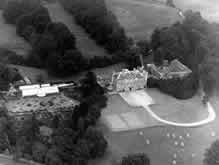

|
It is a reasonable assumption that the first building at Touch would have been a tower. It would have been built of wood, for until the 15th century fortified stone buildings which could be used as a stronghold were forbidden unless they belonged to the King. The tower, which exists today is thought to have been built in the 15th century and probably built in a least two periods. Originally it would have been larger, and of course had no windows on the ground floor. Up to this time the Lairds of Touch were Frasers, and in 1408 it was acquired by the Setons. The Setons extended the house, pulling down part of the tower to make a more substantial although still fortified house. In 1745 Prince Charles Edward, on his way to the Battle of Prestonpans stayed at Touch on the night of September 13th 1745. He gave to his host a quaich, a ring and a miniature and General Murray left behind his dispatch book. These were much treasured by the Setons, and are now held in the safekeeping of an Edinburgh Museum. Later, fleeing from his Hanoverian pursuers after Culloden, he is said to have found refuge in a cave under a waterfall in the Touch Glen, for, with Setonís sympathies well known, the house itself would have been too dangerous. Hugh Seton, together with local lairds, brought families down from the highlands to start the mammoth task of draining the Carse of Stirling. Ditches were dug to float the peat which covered this bogland down to the River Forth, and eventually out to sea. In all an area some 60 square miles was reclaimed, and the rich clay soil which was exposed beneath is now renowned for the production of Timothy hay.
|
|
|


